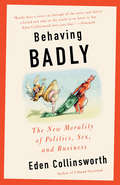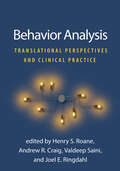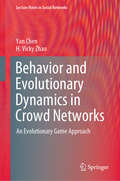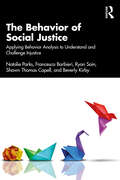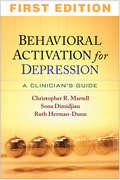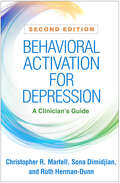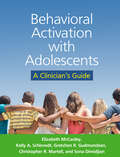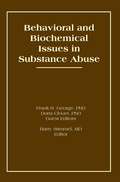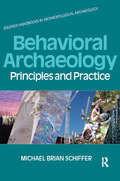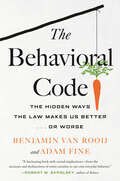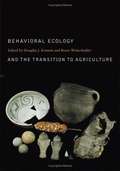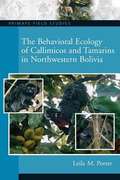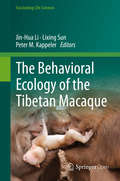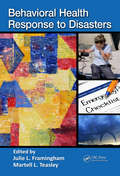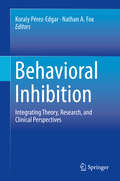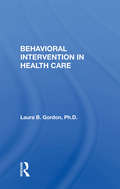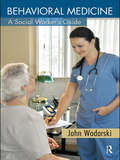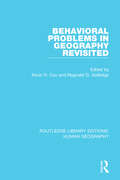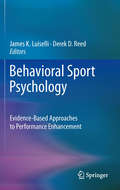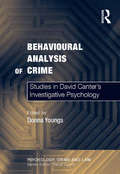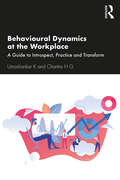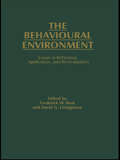- Table View
- List View
Behaving Badly: The New Morality in Politics, Sex, and Business
by Eden CollinsworthWhat is the relevance of morality today? Eden Collinsworth enlists the famous, the infamous, and the heretofore unheard-of to unravel how we make moral choices in an increasingly complex—and ethically flexible—age. To call these unsettling times is an understatement: our political leaders are less and less respectable; in the realm of business, cheating, lying, and stealing are hazily defined; and in daily life, rapidly changing technology offers permission to act in ways inconceivable without it. Yet somehow, this hasn’t quite led to a complete free-for-all—people still draw lines around what is acceptable and what is not. Collinsworth sets out to understand how and why. In her intrepid quest, she squares off with a prime minister, the editor of London’s Financial Times, a holocaust survivor, a pop star, and a former commander of the U.S. Air Force to grapple with the impracticality of applying morals to foreign policy; precisely when morality gets lost in the making of money; what happens to morality without free will; whether “immoral” women are just those having a better time; why celebrities have become the new moral standard-bearers; and if testosterone is morality’s enemy or its hero.
Behavior Analysis: Translational Perspectives and Clinical Practice
by Henry S. Roane Joel E. Ringdahl Andrew R. Craig Valdeep SainiThis is the first comprehensive volume to bridge the gap between the science of behavior and applied behavior analysis (ABA). The book demonstrates how laboratory research informs real-world interventions to facilitate behavior change, and vice versa. Most of the chapters are written by researcher–clinician collaborators, who highlight commonalities and differences in the ways they conceptualize behavior and collect, analyze, and use data. Chapters present translational perspectives on conditioning, reinforcement, extinction, choice, verbal behavior, and more. Ethical considerations in translational research are explored. Training in foundational knowledge is a key requirement for behavior analyst certification, making this a needed resource for current and future ABA practitioners.
Behavior and Evolutionary Dynamics in Crowd Networks: An Evolutionary Game Approach (Lecture Notes in Social Networks)
by Yan Chen H. Vicky ZhaoThis book offers a holistic framework to study behavior and evolutionary dynamics in large-scale, decentralized, and heterogeneous crowd networks. In the emerging crowd cyber-ecosystems, millions of deeply connected individuals, smart devices, government agencies, and enterprises actively interact with each other and influence each other’s decisions. It is crucial to understand such intelligent entities’ behaviors and to study their strategic interactions in order to provide important guidelines on the design of reliable networks capable of predicting and preventing detrimental events with negative impacts on our society and economy.This book reviews the fundamental methodologies to study user interactions and evolutionary dynamics in crowd networks and discusses recent advances in this emerging interdisciplinary research field. Using information diffusion over social networks as an example, it presents a thorough investigation of the impact of user behavior on the network evolution process and demonstrates how this can help improve network performance.Intended for graduate students and researchers from various disciplines, including but not limited to, data science, networking, signal processing, complex systems, and economics, the book encourages researchers in related research fields to explore the many untouched areas in this domain, and ultimately to design crowd networks with efficient, effective, and reliable services.
Behavior in Public Places
by Erving GoffmanErving Goffman effectively extends his argument in favor of a diagnosis of deviant behavior which takes account of the whole social situation.
The Behavior of Social Justice: Applying Behavior Analysis to Understand and Challenge Injustice
by Natalie Parks Francesca Barbieri Ryan Sain Shawn Thomas Capell Beverly KirbyThis seminal work utilizes the principles of applied behavior analysis (ABA) to understand people’s actions. It provides a framework for the study of social injustices that moves beyond just condemning others for their oppressive behaviors, outlining solutions that help work towards a more socially just society.Divided across three main sections, the book outlines the basic principles of applied behavior analysis, considers key tenets of social justice work, and examines how social justice work can be carried out on an individual and a wider institutional level. The first section focuses on the principles of behavior and how it expounds on the causes, reasons, and purposes behind one’s actions. The subsequent sections pay particular attention to how prejudice, stereotypes, and bias play out in society, and how prejudices and biases make us more likely to participate in social injustices. The third section provides a behavioral description of various -isms and discusses the difference between -isms and individual behaviors, before exploring common -isms. The book concludes with an analysis of the reasons behind their persistence, followed by solutions that can be embraced by people.Packed with case studies and reflective questions, The Behavior of Social Justice is an essential reading for students and scholars of behavioral sciences, psychology, sociology and education, as well as academics and researchers interested in the study of social justice.
Behavioral Activation for Depression
by Sona Dimidjian Christopher MartellFrom leading experts in behavioral activation research and clinical practice, this volume presents an empirically tested approach for helping clients overcome depression by becoming active and engaged in their own lives. Behavioral activation is a stand-alone treatment whose principles can be integrated easily with other approaches that therapists already use. Guidelines are presented for identifying individualized treatment targets, monitoring and scheduling \u201cantidepressant\u201d activities--experiences that are likely to be rewarding and pleasurable--and decreasing avoidance and ruminative thinking. Rich clinical illustrations include an extended case example that runs throughout the book. More than 20 activity planning forms, worksheets, and other reproducible materials are featured, which book purchasers can also download and print.
Behavioral Activation for Depression, Second Edition: A Clinician's Guide
by Christopher R. Martell Sona Dimidjian Ruth Herman-DunnNoted for its clarity and practical utility, the definitive guide to behavioral activation (BA) is now in a revised and expanded second edition. The authors are leading experts who enumerate BA principles and provide guidelines for assessment and intervention. Clinicians learn effective procedures for structuring each session, identifying and scheduling antidepressant activities, targeting avoidance and rumination, and monitoring progress. Illustrated with an extended case example, sample dialogues, and quick-reference tables, the book features 16 reproducible worksheets and forms. Purchasers get access to a Web page where they can download and print the reproducible materials--plus a supplemental client booklet--in a convenient 8 1/2" x 11" size. New to This Edition *Reflects a decade of advances in research, clinical practice, and training. *Chapter on transdiagnostic applications and new treatment settings. *Four additional reproducible appendices: measures of BA client progress and therapist treatment fidelity. *Supplemental downloadable booklet: A Client's Guide to Behavioral Activation.
Behavioral Activation with Adolescents: A Clinician's Guide
by Elizabeth McCauley Kelly A. Schloredt Gretchen R. Gudmundsen Christopher R. Martell Sona DimidjianThis book presents the first behavioral activation (BA) program to help 12- to 18-year-olds overcome depression. The authors provide a systematic framework for increasing adolescents' engagement in rewarding activities and decreasing avoidant behavior. User-friendly features include session-by-session guidelines and agendas, sample scripts, and instructional materials. Strategies are described for actively involving parents and tailoring BA to each teen's needs and developmental level. In a large-size format for easy photocopying, the book contains 35 reproducible handouts. Purchasers get access to a Web page where they can download and print the reproducible materials.
Behavioral Analysis of Maternal Filicide (SpringerBriefs in Psychology)
by Tia A. Hoffer Joy Lynn E. Shelton Yvonne E. MuirheadMaternal filicide has been discussed in the medical, mental health, and child abuse fields, yet little research exists with a criminal justice/law enforcement perspective. Nevertheless, criminal justice professionals responsible for investigation and prosecution of these offenders often must give attention to unique behavioral, social, and psychological dynamics not considered in many other types of cases. The Federal Bureau of Investigation's (FBI) Behavioral Analysis Unit (BAU) III - Crimes Against Children identified, collected, and reviewed law enforcement case files in which a biological mother killed her child(ren). Collectively, the cases involve 213 biological mothers who killed 265 children, and are comprised of neonaticide, infanticide, and filicide cases. Data analysis revealed that the offenders ranged in age from 12-46 years, and many were unmarried, unemployed, and had a history of violence. Many of the victims were three years of age or younger, did not live with their biological fathers at the time of their deaths, and had a history of maltreatment most often perpetrated by their mothers. In addition, traditional weapons such as a firearm or knife were used less often compared to asphyxiants and blunt force instruments. The authors explore the tenets of female violence, the mother-child dynamic and mental disorders, and address the complexities associated with investigating and prosecuting maternal filicide offenders.
Behavioral and Biochemical Issues in Substance Abuse
by Barry Stimmel Doris Clouet Frank R GeorgeThis excellent book is a concise yet thorough examination of the important and emerging field of the study of biological risk factors in drug abuse. Historically, drug abuse research has concentrated on the contributions of environmental and behavioral factors as the major influences on addiction. The revelatory studies in this volume examine the genetic contributions to drug taking behavior through the use of animal models, cellular experiments and human clinical studies. Behavioral and Biochemical Issues in Substance Abuse provides for the first time in one volume, up-to-date, easily digested reviews of topics concerning biological and genetic factors in drug abuse. Medical researchers in all areas of alcoholism and drug abuse, researchers in pharmacology, psychology, psychiatry and neuroscience, and clinicians interested in biological approaches to alcoholism and drug abuse problems will benefit greatly from this valuable resource. Authoritative contributors clearly demonstrate the capability of genetic factors to modulate the reinforcing or rewarding effects of drugs, thereby altering their addictive potential. In addition to gaining comprehension of the biological factors affecting addiction, a greater understanding of genetics related to drug abuse will enable future research to control biological factors, leading to more accurate studies of behavioral and environmental influences on drug and alcohol abuse.
Behavioral Archaeology: Principles and Practice (Equinox Handbooks In Anthropological Archaeology Ser.)
by Michael B. SchifferBehavioral archaeology offers a way of examining the past by highlighting human engagement with the material culture of the time. 'Behavioral Archaeology: Principles and Practice' offers a broad overview of the methods and theories used in this approach to archaeology. Opening with an overview of the history and key concepts, the book goes on to systematically cover both principles and practice: the philosophy of science and the scientific method; artifacts and human behavior; archaeological inference; formation processes of the archaeological record; technological change; behavioral change; and ritual and religion. Detailed case studies show the relevance of behavioral method and theory to the wider field of archaeological studies. The book will be invaluable to students of archaeology and anthropology.
The Behavioral Code: The Hidden Ways the Law Makes Us Better or Worse
by Benjamin van Rooij Adam FineFreakonomics for the law—the revolutionary behavioral science insights into how the law fails to reduce misbehavior. Why do some laws radically change behavior whereas others are consistently ignored and routinely broken? Why do we keep relying on harsh punishment against crime even though it continues to fail?Professors Benjamin van Rooij and Adam Fine present the first accessible analysis of behavioral jurisprudence, which will fundamentally alter how we understand the connection between law and human behavior. Drawing upon decades of research, the authors reveal the behavioral code: the root causes and hidden forces that drive human behavior and our responses to society&’s laws.The Behavioral Code offers a necessary and different approach to battling crime and injustice that is based in understanding the science of human misconduct—rather than relying on punishment to shape behavior. The book will show how this code affects all of us using illustrative examples like:· Park rangers in Arizona&’s Petrified Forest who worked with social psychologists to reduce theft—beginning by throwing out &“no stealing&” signs· German walls that &“pee back&” at public urinators· A $2.3 billion legal settlement against Pfizer that revealed how whistleblower protections fail to reduce corporate malfeasance· NYC subway ads that reduced manspreading· How Richmond, California, reduced gun violence by offering young firearm offenders $1,000 monthly rewards for good behaviorRevelatory and counterintuitive, The Behavioral Code catalyzes the conversation about how the law can effectively improve human conduct and respond to some of our most pressing issues today, from police misconduct to corporate malfeasance.
Behavioral Ecology and the Transition to Agriculture
by Douglas J. Kennett Bruce WinterhalderThis innovative volume is the first collective effort by archaeologists and ethnographers to use concepts and models from human behavioral ecology to explore one of the most consequential transitions in human history: the origins of agriculture. Carefully balancing theory and detailed empirical study, and drawing from a series of ethnographic and archaeological case studies from eleven locations--including North and South America, Mesoamerica, Europe, the Near East, Africa, and the Pacific--the contributors to this volume examine the transition from hunting and gathering to farming and herding using a broad set of analytical models and concepts. These include diet breadth, central place foraging, ideal free distribution, discounting, risk sensitivity, population ecology, and costly signaling. An introductory chapter both charts the basics of the theory and notes areas of rapid advance in our understanding of how human subsistence systems evolve. Two concluding chapters by senior archaeologists reflect on the potential for human behavioral ecology to explain domestication and the transition from foraging to farming.
The Behavioral Ecology of Callimicos and Tamarins in Northwestern Bolivia
by Leila M. PorterThe Behavioral Ecology of Callimicos and Tamarins in Northwestern Bolivia offers students a scholary and relevant study of these rainforest dwellers.
The Behavioral Ecology of the Tibetan Macaque (Fascinating Life Sciences)
by Peter M. Kappeler Jin-Hua Li Lixing SunThis open access book summarizes the multi-disciplinary results of one of China’s main primatological research projects on the endemic Tibetan macaque (Macaca thibetana), which had continued for over 30 years, but which had never been reported on systematically. Dedicated to this exceptional Old World monkey, this book makes the work of Chinese primatologists on the social behavior, cooperation, culture, cognition, group dynamics, and emerging technologies in primate research accessible to the international scientific community.One of the most impressive Asian monkeys, and the largest member of its genus, the Tibetan macaque deserves to be better known. This volume goes a long way towards bringing this species into the spotlight with many excellent behavioral analyses from the field. - Frans de Waal, Professor of Psychology, Emory University, USA.Macaques matter. To understand primate patterns and trends, and to gain important insight into humanity, we need to augment and expand our engagement with the most successful and widespread primate genus aside from Homo. This volume focuses on the Tibetan macaque, a fascinating species with much to tell us about social behavior, physiology, complexity and the macaque knack for interfacing with humans. This book is doubly important for primatology in that beyond containing core information on this macaque species, it also reflects an effective integrated collaboration between Chinese scholars and a range of international colleagues—exactly the type of collaborative engagement primatology needs. This volume is a critical contribution to a global primatology. - Agustín Fuentes, Professor of Anthropology, University of Notre Dame, USA. I have many fond memories of my association with Mt. Huangshan research beginning in 1983, when together with Professor Qishan Wang we established this site. It is such a beautiful place and I miss it. It is gratifying to see how far research has progressed since we began work there, becoming more internationalized and very much a collaborative endeavor under the long-term direction of Professor Jin-Hua Li and colleagues. This book highlights the increased interest in this species, representing a variety of disciplines ranging from macro aspects of behavior, cognition and sociality, to micro aspects of microbes, parasites and disease, authored by a group of renowned Chinese and international primatologists. I applaud their efforts and expect more interesting work to come from this site in the years ahead. - Kazuo Wada, Professor Emeritus, Kyoto University, Japan.
Behavioral Health Response to Disasters
by Julie L. Framingham, Martell L. TeasleyDisasters can cause long-term disruptions to the routines of individuals and communities, placing survivors at risk of developing serious mental health and substance abuse problems. Disaster behavioral health services provide emotional support, help normalize stress reactions, assess recovery options, and encourage healthy coping behaviors. They al
Behavioral Inhibition: Integrating Theory, Research, and Clinical Perspectives
by Koraly Pérez-Edgar Nathan A. FoxThis book examines three decades of research on behavioral inhibition (BI), addressing its underlying biological, psychological, and social markers of development and functioning. It offers a theory-to-practice overview of behavioral inhibition and explores its cognitive component as well as its relationship to shyness, anxiety, and social withdrawal. The volume traces the emergence of BI during infancy through its occurrences across childhood. In addition, the book details the biological basis of BI and explores ways in which it is amenable to environmental modeling. Its chapters explore the neural systems underlying developmental milestones, address lingering questions (e.g., limitations of studying BI in laboratory settings and debatable benefits of self-regulatory processes), and provide recommendations for future research.Key areas of coverage include:Animal models of behavioral inhibition.Social functioning and peer relationships in BI.Attention mechanisms in behavioral inhibition.BI and associative learning of fear.Behavioral inhibition and prevention of internalizing distress in early childhood. The relations between BI, cognitive control, and anxiety.Behavioral Inhibition is a must-have resource for researchers, clinicians, scientist-practitioners, and graduate students across such fields as developmental psychology, psychiatry, social work, cognitive and affective developmental neuroscience, child and school psychology, educational psychology, and pediatrics.
Behavioral Intervention In Health Care
by Laura B. GordonIn this book, the author presents a behavioral-psychological perspective on intervention in health care, beginning with a definition of behavioral medicine and introducing the related issues of stress and patient compliance.
Behavioral Medicine: A Social Worker's Guide
by John S. WodarskiHealth care costs and the effective management of health care are of primary importance and concern to federal, state, and local governments. Consequently, it is necessary to develop innovative, successful, and integrated cost-effective treatments and procedures. Behavioral Medicine presents a new model to address these needs. Behavioral Medicine discusses the composition of effective psychosocial treatment and presents a cost analysis of social work and its services. By defining the problems that need to be addressed in health care costs and management, applying research and using studies, this text presents an effective model for health care organizations. It also presents a profile of the Behavioral Social Worker, which defines the abilities needed to be effective in the role and looks at the key impact areas for a behavioral health model. This is a comprehensive guide for social workers preparing to work in health care organizations, and for existing social workers, academics, and practitioners of behavioral medicine in health settings.
Behavioral Methods in Social Welfare: Helping Children, Adults, And Families In Community Settings
by Steven Paul Schinke James. K Whittaker Scott Briar"Behavioral Methods in Social Welfare" offers positive proof that behaviorism has come of age in social work. Steven Paul Schinke and the contributors to this volume are social work practitioners who document their attempts to extend the basic tenets of behavioral psychology from the laboratory, clinic, and classroom to the full range of client groups and social problems that make up the practice of social work. In social work education, traditionally to the extent it appeared in the curriculum at all, behavioral content appeared in electives or in courses not focused on practice. It is a true measure of progress that behavioral methods are now visible, integral component of social work education and practice.The authors of each piece in this collection indicate progress in developing an empirically based approach to social work practice. Despite the impressive documentation contained in the present volume, no conclusive evidence as to the effectiveness of behavioral methods exists. What behavioral methods do offer, however, is a systematic format for both problem intervention and evaluation that, over time, should produce a more empirically based practice. A promising sign, well documented in the present effort, is the facility with which this book has subjected practice procedures to the rigor of research and evaluation.This blending of clinical practice and research develops the sense of competence that student-practitioners acquire in understanding and controlling both the art and science of their clinical practice. Steven Schinke and his colleagues offer a series of "snapshots" of important work in process. Their collective portrait provides a fresh perspective and new stimulus for all social work practice, as well as an affirmation that disciplined, responsive, and sensitive social work intervention can make a difference in the lives of people.
Behavioral Problems in Geography Revisited (Routledge Library Editions: Human Geography #6)
by Kevin R Cox Reginald GolledgeThis collection of papers, originally published in 1981, reviews and evaluates past and possible future advances in a field of central importance to human geography: behavioral geography. The book includes critical studies which show how the approach has contributed substantially to work within four areas of amjor application in behavioral geography: urban travel behavior, environmental cognition, residential mobility and spatial diffusion. The final section of the book focuses on the shortcomings of the behavioral approach and considers the alternative modes of analysis available.
Behavioral Sport Psychology: Evidence-Based Approaches to Performance Enhancement
by James K. Luiselli Derek D. ReedSport psychology is a topic of growing interest. Many professionals read journals such as The International Journal of Sports, Journal of Sport Behavior, Journal of Applied Sport Psychology, Research Quarterly for Exercise and Sport, and The Sport Psychologist. In August 2008, Monitor on Psychology, the monthly publication of the American Psychological Association (APA), featured a special issue on sport psychology. Indeed, Division 47 of APA is devoted to "the scientific, educational, and clinical foundations of exercise and sport psychology." The North American Society for the Psychology of Sport and Physical Activity (NASPSPA) and the Association for the Advancement of Applied Sport Psychology (AAASP) convene conferences each year to present scientific findings and new developments in a rapidly expanding field. The AAASP and other organizations also qualify professionals as certified sport and exercise psychology consultants. Finally, a visit to any bookstore will reveal the lay public's fascination with sports, as revealed in numerous self-help books and guides to perfecting athletic performance. Behavioral psychologists have studied sport psychology for more than three decades (Martin, Thompson, & Regehr, 2004). Applied behavior analysis (ABA), in particular, has been an instrumental approach to behavioral coaching in many sports, including baseball (Osborne, Rudrud, & Zezoney, 1990), basketball (Pates, Cummings, & Maynard, 2002), figure skating (Ming & Martin, 1996), football (Ward & Carnes, 2002), golf (Pates, Oliver, & Maynard, 2001), ice hockey (Rogerson & Hrycaiko, 2002), soccer (Brobst & Ward, 2002), swimming (Hume & Crossman, 1992), and tennis (Allison & Ayllon, 1980). ABA stresses the application of learning theory principles, objective measurement of athletic skills, controlled outcome evaluation, and socially significant behavior-change. Cognitive behavior therapy, or CBT, also has been a dominant approach to psychological intervention in sports (Meyers, Whelan, & Murphy, 1996; Weinberg & Comar, 1994). CBT addresses athletic performance through cognitive-change methods combined with behavioral practice and environmental modifications. The purpose of the book described in this proposal is to compile the most recent experimental and applied research in behavioral sport psychology. Several journal articles have reviewed critical dimensions of behavioral sport psychology (Martin et al., 2004; Martin, Vause, & Schwartzman, 2005) but no book has covered the topic with an emphasis on ABA and CBT methodology and practice. Accordingly, Behavioral Sport Psychology: Evidence-Based Approaches to Performance Enhancement is a first of its kind volume.
Behavioural Analysis of Crime: Studies in David Canter's Investigative Psychology (Psychology, Crime and Law)
by Donna YoungsThe intense interest in 'offender profiling' generated by FBI special agents, gave rise to an explosion of studies in a new area called ’investigative psychology’ by its originator David Canter. This develops understanding of offenders' behaviour that can be harnessed to improve investigations. In this rapidly developing area much has been learnt about what offenders reveal about themselves through their styles of offending. Beyond criminals’ actions the location of their crimes can also reveal where the offender lives or which offences can be linked as part of the same series. Investigative psychologists also explore how to interview witnesses and suspects and assess the veracity of accounts given. The variation in criminal style across crimes as diverse as arson, burglary, hostage negotiation, serial killing and sexual assault is reviewed, using narrative theory and criminals’ emotional experience when offending as the basis for explaining these variations. This provides a framework for drawing inferences about offenders' characteristics. Studies in investigative psychology require a special methodology, developed by David Canter to allow scientific explorations in such a challenging field, previously assumed not to be open empirical study. The practical potential and applications of the research are given, as well as a selection of commentaries on the cutting edge debates that are driving the future of the investigative psychology. This new discipline is of relevance to forensic psychologists in many different settings, criminologists and law enforcement agencies, bringing together work that lays out current achievements and sets the agenda for future research in the field.
Behavioural Dynamics at the Workplace: A Guide to Introspect, Practice and Transform
by Umashankar K Charitra H GThis book offers strategies and effective ways for professional improvement in the workplace. It focuses on behavioural dynamics in a work environment, and offers perspectives on self-assessment, critical thinking, experiential learning, stress management and information processing. The book discusses concepts like self-image and self-concept which have been aligned with professional excellence and provides a psychoanalytic and theoretical understanding of organizational dynamics, individual and group behaviour, and the expectations of the contemporary corporate world. Through case studies, stories, helpful questionnaires and guides, the volume offers tools and practical solutions for young professionals to develop essential skills to thrive in their careers. It also highlights the importance of effective listening, communication, and identifying cognitive, behavioural and transpersonal patterns for professional and personal development. Insightful and detailed, the book is an essential read for students and professionals in the field of management, business communication, human resource, and behavioural psychology. It will also be of great use to young professionals working in various sectors who are interested in learning about organizational dynamics.
The Behavioural Environment: Essays in Reflection, Application and Re-evaluation
by Frederick W. Boal David N. LivingstonePlacing human action and perception at the centre of the subject, this book considers the effects of mankind on the environment, drawing particularly from William Kirk's work on the behavioural environment model. Reviewing Kirk's original model in light of recent ideological debate and extensive new evidence, this collection of essays from leading names in the field shows that a behavioural approach is essential in understanding human geography and man's relationship with the ecological environment.
